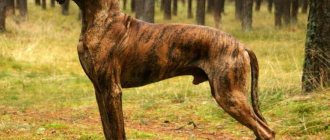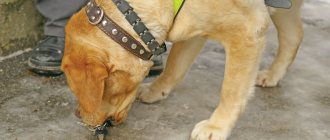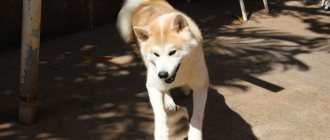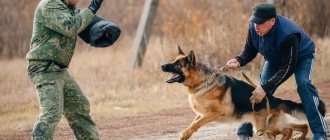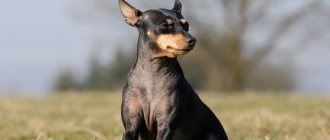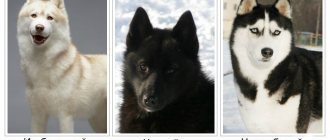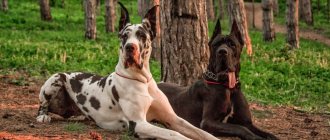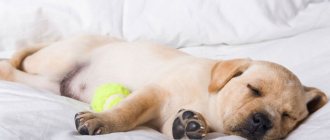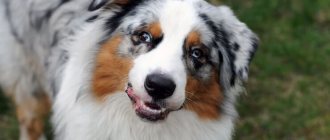Recognized
There are quite a few recognized breeds of the Russian dog breeding school on the world stage. They were often developed many decades ago, so the basic standard has managed to not only gain a foothold, but is also loved by many.
Like the advertised European breeds, they participate in all international exhibitions and represent the heritage of world dog breeding. In addition, these breeds have become so successful that they have brought fame to Russian dog breeders around the world.
South Russian Shepherd
The South Russian Shepherd Dog is one of the oldest herding breeds. It was bred in the southwest of the Russian Empire at the beginning of the 18th century on the territory of the Crimea peninsula.
The creation of the breed involved Asian molossoids, greyhound breeds and the extinct Crimean greyhound, as well as the Crimean shepherd dog. The South Russian Shepherd Dog was officially recognized not so long ago; it was included in the FCI register in 1996.
Main features of the breed:
- the dog is large, its height at the withers is 60-68 cm, weight is about 55 kg;
- the coat is long and thick, evenly covering the entire body, which is why the breed is sometimes called the “huge lapdog”;
- the color of the coat can be cream, snow-white or smoky shades, the undercoat is predominantly grayish tones;
- despite the external slowness and kindness, the dog is quite graceful, and in a dangerous situation it will be able to protect the owner and his property at any cost;
- Family comes first for the South Russian Shepherd, so the dog easily accepts all family members and even new animals.
Important! South Russian Shepherd dogs recognize only one family member as the real owner, so the dog’s upbringing should be done exclusively by the head of the family.
Black Russian Terrier
The Black Russian Terrier is a widely known variety of working dog on the world stage, bred in the second half of the twentieth century within the walls of the famous Krasnaya Zvezda kennel.
The original breed was the Giant Schnauzer, which was crossed with 15 breeds, including Airedale Terrier, Newfoundland and Rottweiler. The FCI was officially recognized in 1983.
We advise you to find out which breeds are classified as terriers: parts 1 and 2.
Main features of the breed:
- This is a fairly large dog; with a height at the withers of about 71 cm, it weighs about 60 kg;
- the Black Russian Terrier has a powerful and muscular, but harmonious body;
- the coat is coarse, double, consists of a soft and short undercoat, as well as long guard hair (from 5 to 15 cm), which completely covers the entire body;
- on the face, the hair forms characteristic eyebrows, beard and mustache;
- the color of the hair is always black, with a uniform shade throughout the body;
- The dog is friendly, not aggressive, but in case of danger it instantly takes a defensive position and is able to protect its owner.
Important! The Black Russian Terrier requires special attention at the training stage, otherwise there is a possibility of raising a disobedient and uncontrollable dog.
Central asian shepherd dog
One of the most traditional varieties of “Russian breeds” is the Central Asian Shepherd Dog (Alabai). This animal is considered an indigenous inhabitant of the Asian zone of Russia, therefore, since ancient times, all residents of this territory have actively bred this dog as the best assistant when walking livestock.
The breed was bred through natural selection on the basis of ancient mastiffs, but it was only by the middle of the twentieth century that all its main characteristics were successfully consolidated, thanks to targeted selection. The FCI only recognized the breed in 1989.
Main features of the breed:
- The Central Asian Shepherd is one of the largest dogs in the world , its height at the withers reaches 70 cm, and its weight can be about 80 kg;
- The dog’s body is powerful, muscular, the length of the forelimbs is equal to half the length of the body;
- the wool is thick and dense, according to the official standard it can be either short or reach a length of 10 cm;
- the hair forms a lush mane, fluffy tail and “pants”;
- coat color can be varied, but any combination of blue and brown shades is unacceptable;
- The animal is formidable, fearless and brave, but treats children with tenderness and trepidation.
The most famous types of shepherd dog breeds are Caucasian, Scottish, Belgian and German. But they also distinguish: Sheltie, Bobtail, Komondor, Malinois, Australian Shepherd, Swiss, Oriental and Maremmo-Abruzzese Shepherd.
Caucasian Shepherd Dog
The Caucasian Shepherd Dog is a traditional resident of the Caucasus and surrounding regions. The breed appeared as a result of natural selection and natural mutation several thousand years ago, but was repeatedly modified in order to improve guard and herding abilities.
Presumably, the ancient relatives of this dog are the so-called “Tibetan Great Danes”, but no reliable confirmation of this has yet been found. Selective breeding of purebred individuals began at the beginning of the twentieth century and already in 1984 the FCI officially recognized it.
Main features of the breed:
- The height of the dog at the withers reaches 75 cm, the average weight is about 50-70 kg, but can reach up to 110 kg.
- The dog's body is powerful and wide, with thick hair;
- hair can be of three types: short, long and intermediate, but this does not contradict the breed standards;
- The coat color can be varied: wolf-gray, brown, white, fawn, with and without a mask, red and motley;
- Caucasian Shepherd Dogs are distinguished by persistence, determination and courage, as well as increased distrust of strangers.
Did you know? Domestic dogs were identified as a separate biological species in 1758, thanks to the world famous Swedish naturalist Carl Linnaeus.
Russian-European Laika
The Russian-European Laika breed was bred for hunting purposes in the second half of the 60s of the twentieth century by crossing all kinds of Laika breeds (Arkhangelsk, Kirov, Kostroma, etc.).
The work of Soviet livestock specialists became so successful that by 1975 the number of dog individuals exceeded 1 thousand, so in 1980 the FCI, together with Soviet dog handlers, determined the basic standards of the breed, after which the Laika received international recognition.
Main features of the breed:
- The Russian-European husky has an average body size, its height does not exceed 58 cm, and its weight is 23 kg;
- the physique is proportional, strong, but the skeleton is not wide, slightly elongated;
- The husky's coat is short, straight, coarse, with a soft undercoat; in the area of the neck, withers and shoulders it forms a lush collar; on the hind legs the hairline is slightly elongated and forms characteristic “pants”;
- coat color can be black and piebald or white and black;
- the tail can be straight, but often it is bent into a ring;
- The dog's character is restive, tough, he is characterized by fearlessness and self-confidence, however, such animals are not aggressive towards others.
East Siberian Laika
The East Siberian Laika is an animal that is an active companion of humans in the difficult climatic conditions of Siberia both in ancient times and to this day. The ancestors of this dog were the hunting and sledding breeds of the Evenki group, which were additionally crossed with Tunguska dogs.
Until the 19th century, the selection of these dogs occurred naturally, but then the population of Siberia gradually bred purebred individuals, crossing exclusively dogs of the same type based on morphological characteristics. The breed received official recognition from the FCI in 1980.
Main features of the breed:
- the height at the withers of the East Siberian Laika is about 55-64 cm, the average weight does not exceed 23 kg;
- The physique of such dogs is strong, the body is powerful and muscular, but this does not reduce the mobility of the animal;
- the length of the front legs is equal to half the height of the withers;
- the tail is long and curled into a ring;
- the coat is long and thick, it forms a pronounced collar on the neck and chest, and a thick scruff at the withers;
- the color can be varied, mainly white and black, gray, red and white, black and piebald, brown, black shades, but the color can also be monochromatic;
- East Siberian Laikas are distinguished by their energy and mobility, they are characterized by masculinity, endurance and minimal anger towards strangers.
West Siberian Laika
West Siberian Laikas are representatives of the northern branch of hunting dogs. The ancestors of these animals are ancient species of huskies that inhabited the territory of Siberia and the Urals.
In addition, the pedigree of this husky also contains genes from ancient outsider wolves, which the Khanty and Mansy actively domesticated and used for economic purposes.
The breeding of purebred animals began at the beginning of the twentieth century, and by 1939, persistent traits had formed. West Siberian Laikas were recognized by the FCI only in 1980.
Unrecognized
In modern dog breeding, there are many unrecognized varieties of dogs.
There are many reasons for this, since this process is no less lengthy than creating a dog with new morphological features. However, this does not mean that they are devoid of originality and uniqueness.
East European Shepherd
The East European Shepherd was created by Soviet cynologists in the 40s-50s of the twentieth century within the walls of the famous kennel “Red Star”. The animal was bred on the basis of the world famous German Shepherd as a result of purebred crossing (without the addition of the genotype of other breeds).
As a result of this, Soviet dog handlers managed to obtain a more powerful and hardy dog, suitable for use in any climatic regions. The persistent morphological characteristics of the East European Shepherd were established in 1964; today the breed is recognized only by Russian dog handlers.
Main features of the breed:
- East European Shepherds have a moderately elongated body, height at the withers is average or above average and ranges from 62-76 cm, weight ranges from 30 to 60 kg;
- strong physique with strong bones and developed muscles;
- the length of the body often exceeds the height at the withers by 10-15%, while the length of the head is about 40% of the height at the withers;
- the hair is straight, close-lying, uniform, of medium length, but in the area of the head, ears and paws it is shorter;
- coat color: saddleback, black with a dark mask on a light background;
- The dog's character is quite complex; it is a confident, courageous and distrustful animal of strangers, but at the same time restrained and balanced.
Moscow watchdog
The Moscow Watchdog was bred in the 50s of the 20th century within the walls of the military kennel “Red Star” by crossing such breeds as: St. Bernard, Caucasian Shepherd, Russian Piebald Hound. The dog was created for guard, guard and sentry service, so the dog has excellent endurance and can also be trained without much difficulty. Today the breed is still on the path of its formation.
Main features:
- the height of the animal ranges from 65 to 78 cm, and the body weight reaches 60 kg or more;
- This is a large dog with powerful bones and muscles, the dog’s body is slightly elongated, its paws are large and long;
- the coat is thick and long, the undercoat is also long, lying close to the body;
- near the head six is slightly shortened, but in the area of the neck and hind legs it can be longer;
- the color of the dog is white-red or white-red-brown;
- The Moscow Watchdog is a unique mixture of characters, it perfectly combines aggressiveness and suspicion of strangers, as well as true love and devotion to its owner.
Chukotka sledding
One of the indigenous inhabitants of the harsh regions of Northeast Asia is the Chukchi sled dog. This breed of dog was bred as a result of natural selection, with the participation of the population of Chukotka and surrounding regions, on the basis of aboriginal sled huskies. Its main purpose is to be a traction force when transporting people and goods. Despite the fact that the dog is not recognized by the FCI, it has persistent characteristics, and has also been actively bred for decades in arctic and subarctic climates.
Check out the sled dog breeds.
Main features of the breed:
- the Chukotka sled dog is a medium-sized animal, its height at the withers reaches 55-65 cm, and its weight ranges from 20 to 30 kg;
- the body is slightly elongated, with powerful bones and muscles;
- the coat is thick, dense, uniform, about 6 cm long, in the area of the neck, withers and hips the hairline is somewhat elongated (8-10 cm);
- the dog’s undercoat is thick, dense and waterproof, this allows the animal to spend the night right in the snow without a threat to health;
- the color is predominantly red, white, brown, black, spotted, piebald, tan, often zone-gray, zone-red or light fawn; The breed is particularly friendly to humans, as well as a calm and balanced character.
Yakut Laika
Yakut Laikas are considered to be the aboriginal inhabitants of the northern regions of Russia. These animals were bred in the 17th century by the population of the Nizhnekolymsk region of Yakutia for economic needs.
The dog was actively used as a traction force, for hunting purposes, and also for herding herds of deer. Today, the population of this husky has been somewhat reduced, but active work is underway to restore it.
Important! A uniform coat color is an unacceptable defect for Yakut Laikas, with the exception of the snow-white color.
Main features of the breed:
- the animal's height at the withers ranges from 55 to 59 cm, body weight on average no more than 25 kg;
- These are strong and muscular dogs, but at the same time their body is compact, their paws are set high;
- the coat is thick and harsh, with a thick layer of undercoat;
- the hairline is almost uniform, but in the area of the neck and paws it is elongated, which forms a characteristic mane and fringe;
- the coat color is predominantly spotted, the following combinations of shades are allowed: black and white, gray and white, white and black, white and gray, white and black with red spots;
- The dog has a freedom-loving and non-aggressive character, as well as an increased curiosity about the world around him.
Nenets reindeer laika
The Nenets reindeer laika is one of the oldest aboriginal inhabitants of the northern regions of Russia. The breed appeared as a result of natural mutation processes at the end of the last ice age, after which it was tamed by humans and actively settled throughout the tundra and forest-tundra. The dog is actively used in search and security work to this day, but is recognized only by the Russian Canine Federation.
Did you know? The Nenets reindeer husky is one of the few breeds that has preserved the features inherent in primitive dogs.
Main features of the breed:
- The dog's body size is average, the height at the withers is 41-53 cm, and the weight does not exceed 25 kg;
- the body is compact, muscular, with dense bones, slightly elongated;
- the limbs are straight, the hind legs are set wider than the front ones;
- the tail can be closed in a ring or lowered;
- the coat is dense, with a thick undercoat and dense guard hair, its length is at least 8 cm, and in the tail area it can reach 25 cm;
- The color of the reindeer husky is varied, there are shades of black, brown, gray, in combination with white spots;
- The breed is distinguished by its special affection for a person and his family; for the Nenets Laika it is important to always stay close to the owner and not let him out of sight even for a second.
Russian hound
There is no single theory about the origin of Russian hounds yet. According to the general opinion, these dogs appeared as a result of natural genetic selection. The ancestors of the dog are considered to be local breeds of huskies and imported pointing dogs.
The animal became a favorite hunting assistant for both the nobility and ordinary peasants, so in 1874 active work began on breeding purebred individuals with improved hunting qualities, and by 1925 a full-fledged standard appeared. However, to this day the Russian hound is recognized only by Russian dog breeding organizations.
Main features of the breed:
- the height of the animal is 55-68 cm, while the body weight does not exceed 30 kg;
- the body is strong and muscular, but slender, of medium size;
- a characteristic feature of the breed are triangular-shaped ears hanging down;
- the coat is dense, with a thick and soft undercoat; it is short on the head, ears and legs, but elongated in other areas of the body; in the neck area the hair forms a scruff;
- The color of the dog can be underhair, saddle-haired or crimson, the color of the undercoat is always lighter than the guard hair;
- The Russian hound has a calm and balanced temperament, is friendly to humans, and during the hunt the animal shows particular anger towards its prey.
Russian piebald hound
Russian piebald hounds are one of the most common hunting dogs in Russian-speaking Europe. Dog breeding began in the second half of the 19th century. The animal was bred by crossing English and French hounds.
In 1925, the dog received stable signs, but to this day the FCI has not recognized it.
Main features of the breed:
- the height of the animal at the withers reaches 55-65 cm, body weight can be varied and is not regulated by any standard;
- these are elegant and proportional dogs with developed muscles and strong bones;
- the hair is short, on the paws and ears it is much shorter than on other parts of the body;
- the paws are often snow-white, the body is covered with red and black spots, the size of the spots can be varied, up to the complete coloring of the body;
- The Russian piebald hound has an affectionate and friendly character; they are playful and intelligent dogs capable of showing perseverance and courage.
Russian hunting spaniel
This dog is a hunting gun breed that was bred in 1951. It is based on various varieties of spaniels, but the main ancestors are English cocker spaniels and springer spaniels. The dog was bred for highly specific purposes; its task is to actively assist humans in hunting hares.
Find out what are the features of keeping: Irish Water Spaniel, Russian Spaniel, Cavalier King Charles Spaniel.
Main features of the breed:
- the height at the withers of representatives of the breed often does not exceed 44 cm, weight is about 15-20 kg;
- The Russian hunting spaniel is characterized by medium size, elongated, strong, but dry and muscular body, with large bones;
- the coat is soft and shiny, in the area of the head and front of the paws the hair is short and straight, in the area of the neck, back and on the sides it is longer;
- The coat color is uniform, mainly black, red or brown shades, black-piebald, brown-piebald and red-piebald tones are also found;
- The dog has a calm and friendly disposition, they are loyal to humans and are often very trainable.
Russian Tsvetnaya lap dog
The Russian Tsvetnaya lap dog was bred for decorative purposes in the 50s of the twentieth century. It was created by crossing various dwarf breeds brought to the USSR in the post-war period. The animal became the first decorative dog on the territory of the Soviet Union and is still considered one of the best companion dogs.
Did you know? According to genetic research by the American scientist Robert Wayne, conducted in 2007, it was found that the separation of the dog from the genus of wolves into an independent group occurred about 135 thousand years ago.
Main features of the breed:
- these dogs are quite modest in size, the height at the withers does not exceed 25 cm, and the weight is about 3-4 kg;
- the build is strong, the body shape is slightly stretched, but the dog looks harmonious;
- the coat is long, thick, shiny and silky, with a well-developed and dense undercoat, in most cases it forms characteristic large curls on the body, and a mustache and beard on the muzzle;
- The hair color is uniform, it can have a variety of shades, but pure white color is considered a defect.
Review of Russian dog breeds
Many Russian dog breeds, especially those recognized by the FCI, are known and popular throughout the world. The following breeds can be considered the most striking achievements of Russian cynological activity.
Samoyed dog
Samoyeds, or Samoyed huskies, are medium-sized dogs (from 17 to 30 kg, height at the withers for males 54–60 cm, and for females 50–56 cm). In their native form, representatives appeared in the 11th century BC, but the modern breed was formed at the beginning of the 20th century. The breed is recognized by both the Russian and International Cynological Federations.
Samoyeds have white fur and a tail carried over their back.
A distinctive feature of the appearance is long white hair and a tail thrown over the back. Life expectancy is 12–15 years, the dogs are quite strong and rarely get sick. By nature, representatives of the breed are very contradictory; they are cheerful and friendly, but they will not obey unquestioningly and can show their stubbornness. The main difficulty in keeping them lies in their upbringing, including due to their tendency to wander. Otherwise, they are very playful and interesting dogs that get along well in families with children.
In fact, most people, when they see a Samoyed, immediately imagine many problems with caring for such a beautiful dog. In fact, there is practically no hassle, except for compliance, to some extent, with a specific feeding diet (you cannot give red foods, bread, etc.). Wool has the ability to clean itself very easily even after a walk in dirty weather; you just need to comb it. This gives an even greater effect than bathing.
Elta
https://husky.com.ua/forum/threads/115/
Buryat-Mongolian wolfhound
The Buryat-Mongolian wolfhound (hotosho) is a guard breed, the representatives of which are distinguished by good health and unpretentious maintenance. The breed has been recognized by the RKF since 2006, but has no international recognition. Such dogs have a stable psyche and the ability to quickly adapt to new conditions, which makes them exemplary pets, especially for families with children.
Khotosho are dogs above average height, strong build with a developed muscle corset. They have a straight and coarse coat with a soft undercoat, which is available in 3 lengths:
- long (15–20 cm);
- intermediate (8–10 cm);
- short-haired.
Buryat-Mongolian wolfhounds are large dogs with a stable psyche that do not have international recognition
The color is preferably tan (black with red markings). Height for males is not less than 74 cm, for females - not less than 66 cm. Khotosho requires proper upbringing and a steady hand, so it is not suitable for a novice dog breeder. In addition, dogs are subject to active shedding in the summer, regardless of the length of their coat.
Caucasian Shepherd Dog
The Caucasian Shepherd Dog, or wolfhound, is a large, strong and muscular dog. The height of females is at least 64 cm, for males - 68 cm, with a lower weight limit of 45 and 50 kg, respectively. She has a massive and long body, a wide head with high-set ears, a short muzzle with a large black nose and dark almond-shaped eyes. The coat can be short, intermediate or long. The most common coat color is gray with rusty shades, but the dog can also be beige, white, cream, brown, tabby or spotted. The breed is recognized by both the RKF and the FCI.
Wolfhounds are famous for their brave and vigilant guards; they faithfully serve their master and protect their family. Their distrustful and independent nature makes them wary of strangers. In relation to relatives, he usually strives to dominate, but gets along well with children.
Caucasian Shepherds have a highly refined guarding instinct.
The main disadvantage of the animal is its innate aggression towards strangers, which requires proper education and early socialization. But a significant advantage can be considered endurance and the ability to quickly adapt to any climatic conditions. Such a dog lives on average 10–11 years, enjoying good health. The danger is posed by ailments characteristic of large breeds (joint dysplasia, gastric volvulus, etc.).
Once upon a time, about 17 years ago, I had a Caucasian Shepherd. She had the same analytical brains, was 67cm tall at the withers, broad-chested, lightning fast in her throws, with an easy stride. Nowadays you see only a few of these, and then on the periphery, away from, or more simply, away from megacities, where the owners are little affected by the laws of dog show business. I recently went to Moscow for the Mayor’s Cup and the World Cup, but, of course, I didn’t meet the old-style Caucasians. Mostly elephant-shaped monsters are led into the ring.
Galina Nikolaevna
https://forum-eurasica.ru/index.php?/topic/813-Caucasian-Shepherd/
Russian toy
The Russian Toy is a breed, the creation of which was carried out in the middle of the 20th century in the USSR with the goal of obtaining decorative pets similar to English Toy Terriers. The breed is registered in the RKF system, and in 2021 received recognition on a permanent basis in the FCI system. Visually, these are small (20–28 cm at the withers) dogs with high and thin limbs with dry muscles. On the head there is a striking feature of the breed - large ears, shaped like a candle flame. Today there are two types of toy:
- smooth-haired (with short, close-lying and shiny coat);
- long-haired (with moderately long, 3–5 cm hair, straight or slightly wavy).
Colors are allowed in several variants: black, lilac and brown and tan, fawn, red of any shade, including with a dark coating.
Russian Toys are energetic companions devoted to their owner.
By nature, Russian Toys are energetic, active and playful dogs, loyal and affectionate to their owner. The animal's psyche is susceptible to stress, so it is not worth living next to noisy small children. This is a simple pet to keep and can be trained to use a litter tray. The main disadvantage is health; due to its size, the animal has a hard time withstanding mechanical, viral and temperature influences. Average life expectancy is 13–15 years.
Initially, the breed was called the “Moscow Toy Terrier,” but during the procedure for recognition at the international level, the commission did not note signs of a terrier among the representatives, so this word was simply removed from the name.
Many people say that this dog is not for families with children, and because of this people have a stereotype that it is not for children - it means it hates children, is aggressive, etc.) in fact, everything is just the opposite - this is a gentle dog tender not only in soul and heart, but also no less tender in her fragile body. Children, simply not calculating their strength or activity, can damage or kill this small animal. I have seen orthopedic operations on toy terriers - the needles go into the bones. Like butter, such bones are really very easy to break. let the children breed a shepherd dog or a labrador, do not buy a toy dog for small children!
Seahorse
https://irecommend.ru/content/otzyv-veterinarnogo-vracha-i-vladeltsa-v-odnom-litse-vsya-pravda
Russian hound
The exact time of origin of the Russian hound is unknown, but it is believed that it happened in the 5th–6th century. Purposeful work on the breed has been carried out since the second half of the 19th century in Russia. Today, representatives of the breed are used as fox and hare hunters. It exists in the RKF system, but is not recognized at the international level.
These are medium-sized dogs, weighing 25–30 kg and height at the withers from 55 to 68 cm. Representatives of the breed are strong and muscular, have a small head and an elongated muzzle. Features of the exterior are hanging triangular ears and almond-shaped brown eyes. By nature, hounds are very friendly to all family members, they are smart and unobtrusive, energetic and active. The main attention should be paid to the upbringing of the animal, since with improper or late socialization, dogs can show aggression towards their relatives. If the owner does not have enough time to communicate and play with the dog, then its energy will become a disadvantage, resulting in destructive behavior.
Russian Hounds are very energetic dogs that require significant exercise.
The lifespan of a dog is 10–12 years. Health can be described as good, but there are diseases characteristic of this breed (joint dysplasia, myositis (muscle inflammation)).
Siberian Husky
The Siberian Husky is a breed bred in northeastern Siberia, its representatives are considered sled dogs and companion dogs. It was officially registered in the ICF system in 1966. Visually, they are light and compact, with a slightly lowered back line and a fluffy tail. Huskies have erect triangular ears, and eyes can be of any color, including different colors (heterochromia is allowed). The husky's coat is not long, but thick and warm, its color can be any, but the most common are white-black and gray-white.
Siberian Huskies were bred as sled dogs, but today they are also excellent companions.
According to the FCI documentation, the Siberian Husky is an American breed, since it was American dog handlers who applied for its registration in the 1930s. However, it was actually developed in Russia.
Siberian Huskies are friendly and calm, but also very lively and active. They are categorically not suitable for official roles, as they are very independent. Excellent mental abilities allow the pet to learn well, but productivity will require frequent games and distractions. Their harmlessness, including towards children, can be considered an advantage, but a big disadvantage is their desire to run away and love of digging, including in the house.
The average lifespan of a dog is 12–15 years. As a breed from northern latitudes, Siberian Huskies enjoy good health, but may have hereditary diseases such as diabetes or hip dysplasia.
It seems to me that people who dream of having a fantastically beautiful dog need to know and take into account the key points in the character of the husky breed in order to assess their strengths and be sure that you can handle it. The first thing I want to highlight is that he is a very active dog. The breed was bred to help the people of the North, mainly for riding, so the dogs are very hardy and energetic. During the day, she accumulates so much energy that she needs to walk the dog at least three times (at best, an hour). Secondly, even if you follow the walking regime well, i.e. When providing your dog with freedom, you need to take into account the size of the apartment. Ideally, it is better to keep huskies in a country house or in a spacious apartment. And one more thing - huskies love to run. These are very freedom-loving creatures and you need to control when and where you let your dog off the leash. Bayra ran away several times. And it almost always looked like this: you take it out for a walk - you meet a familiar dog - you let your dog off the leash so they can play - the dogs are playing - the husky wedges from something - she is already a trembling doe rushing into the fog... Almost always we caught a runaway somewhere - somewhere in the bushes, eating some kind of crap (this strange craving for eating all sorts of crap once almost cost Bayra his life).
Julia
https://irecommend.ru/content/etot-otzyv-dlya-tekh-kto-sobiraetsya-zavodit-khaski-propuskaem-mi-mi-mi-i-uchityvaem-vazhnye


